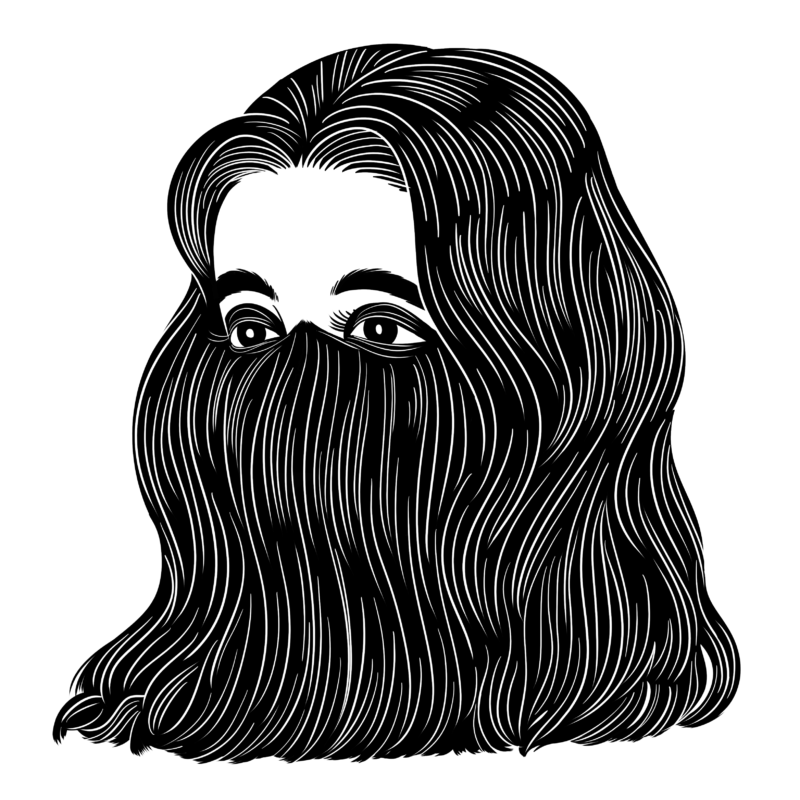The Trojan Women by Anne Carson and Rosanna Bruno
In this graphic novel, a collaboration between poet Anne Carson and visual artist Rosanna Bruno, Euripides’s tragedy gets a new life—and new life-forms. Here the entire cast of characters takes the shape of animals or inanimate objects. In the fourth panel, Poseidon, depicted as a large wave of exactly six hundred cubic feet, bursts in, saying, “That mob of dogs and cats you see downstage—prisoners of war, leftover females. Brains brimming. They’ll never get to use their brains again—slaves don’t. They bark and wail—ignore it.” And so the stage is set. The women have been silenced. Hekabe, once a queen of Troy so ruthless in her grief that she found herself capable of murder, assumes her final form as a malnourished dog worn to the bone. The one exception is her daughter Kassandra, the woman whose prophecies are always true yet never to be believed. She maintains her human form, speaking of Agamemnon, of her future, and of fate, in her human voice. And yet her warnings are dismissed. In an era when the plea for women to be not just heard but believed resounds louder than ever, this depiction of a doomed soothsayer is a reminder of the battles not yet won.
Bina: A Novel In Warnings by Anakana Schofield
The seductive subtitle of Anakana Schofield’s Bina is A Novel in Warnings. There’s even an index of warnings at the back of the book: “Do not open your heart”; “Say No”; “Careful on the internets”; “Write it all down. All of it. Record it the way I am doing for you.” (Another: “If a man comes to your door, do not open it. Unless it’s David Bowie.”) The eponymous Bina, a charmingly bitter elderly woman, has had a lifetime of experiences to justify her skepticism about others, her insistence on solitude. Poor Bina: systematically stolen from by a young man she helped years ago; grieving the death of her best friend as she volunteers for a euthanasia group whose dealings she is being persecuted for. “I’m not a young person so I am used to being ignored. I expect you won’t listen,” she says, daring us to defy her expectations. The push and pull of Bina’s voice holds us captive. Leave me alone, she seems to be saying—but also: Come here. Pull up a stool. Like many women of a certain age, she’s weary, having had to carry so many and so much in this life. Yet Bina can’t shake her natural inclination to reach out one more time. Is not every warning, in a sense, a kind act? A desire that someone else might lead a different and better life: a small, practical form of hope.
The Inland Sea by Madeleine Watts
The novel The Inland Sea opens with an epigraph from Anne Carson’s translation of Agamemnon: Kassandra saying, “Who cares? The future is coming.” A fitting segue into a book about a woman with her feet in two tenses: the present and the future. Worry is transportive—it allows us to occupy the present and the future at once. Anxiety, then, feels like a total collapse of time, one tense crashing into the next. In The Inland Sea, everything seeps. Heat enshrouds the story. It’s in our unnamed narrator’s house, radiating through the bricks. It blurs lines, smudges, makes everything a little hazy. Outside, wildfires ravage the countryside, causing a host of other catastrophes. We’re not allowed to forget this, because our narrator, an Australian writer drifting through life after college, can’t. Her anxiety leaves a film over everything, making our skin itch. At her part-time job as an emergency dispatch operator, she is constantly fielding dangerous situations. It falls on her to get the details just right, to send for help. In these moments, when the conversations of people in crisis are captured, the lack of quotation marks is notable. Water cooler chat rubs up against peril. The language of emergencies, the panic of other people—they bleed into her life. She hears a woman get attacked by a man; she keeps keys between her fingers on her late-night walks home. (Her friends do, too, heeding her warning.) A refrain: “The future is coming and it doesn’t look good.” Someone says it to her, and now she’s telling it to us. That’s the other thing about worry, especially when it’s about our planet, our shared fate: It can be a collective emotion. It binds us to other people.





